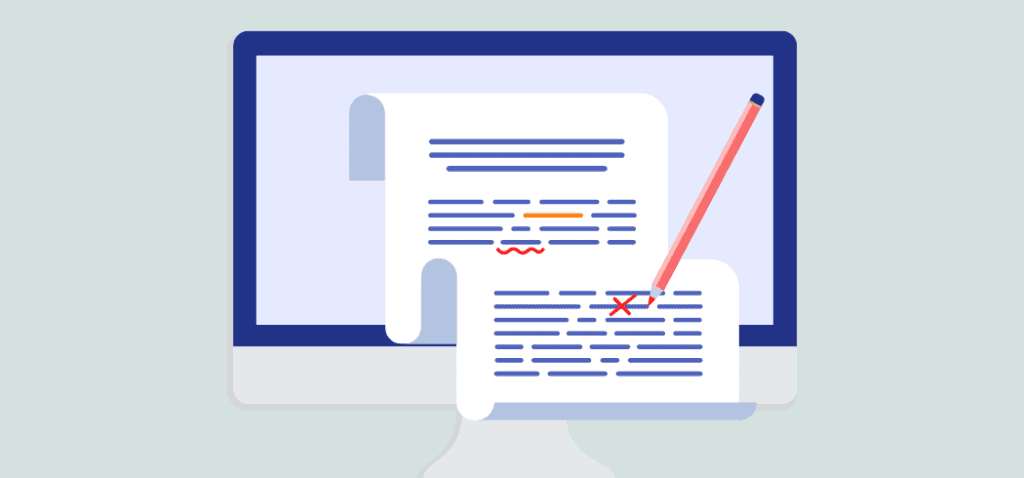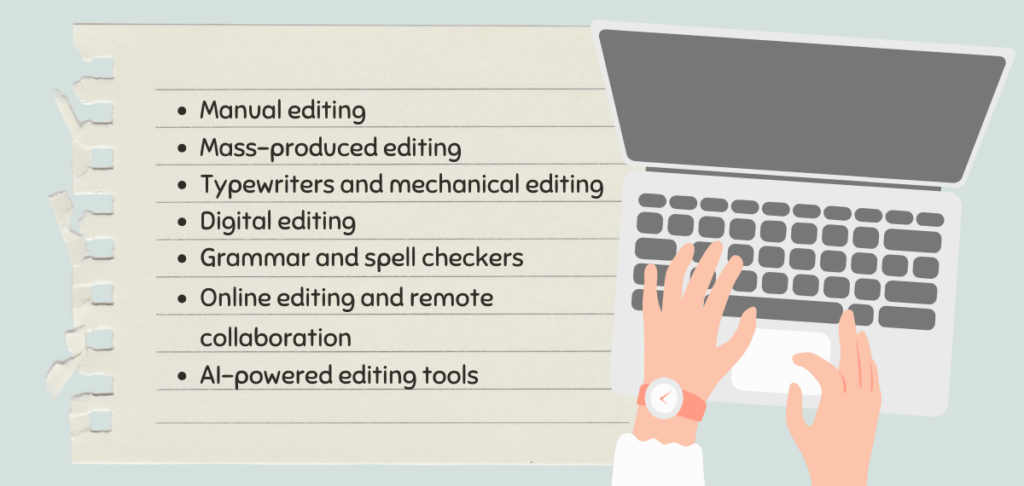Editing is the process of revising and refining a written work to improve its clarity, coherence, effectiveness, and overall quality. Editing has been used since the written word first appeared and has evolved through the ages to embody the detailed structural and grammatical steps applied today.
It involves reviewing and changing various aspects of the writing process, such as its structure, content, language, style, grammar, and formatting. This application is a crucial first step to ensure your material is understandable to your audience.
Keep reading to understand the importance of the editing process, what steps you can take to be successful with its applications, and even explore its evolution since ancient times. By the end of this article, you should fully understand why and how to apply editing for a clear and concise writing structure.
Why Is Editing Important?

The primary goal of editing is to enhance the readability and impact of the written work, ensuring that it effectively communicates the intended message to the reader.
It is an essential step in the writing process that helps refine and polish how information is organized and shared. It addresses the overall structure to provide coherent, clear, and error-free information, making it more effective and engaging for its intended audience.
For people comfortable with writing, the editing process comes naturally and is usually ingrained into the material as it is being written. This step concerns the overall organization and how information is placed within context. But, even for the most experienced writer, taking the time to review the structure of the work, the reliability and use of information, and the overall flow is paramount.
As an experienced writer, I find myself from time to time questioning how I should best change my writing to make it clearer to my reader. Checking the accuracy of the information and basic grammar is never a step I ignore.
For those new to the writing process, following the various editing steps is crucial to ensure your message is understandable. These steps are explained and defined below to help you put them into practice!
Take your grammar skills to the next level
Take Our Copyediting Course
What Are the Different Types of Editing?
The editing process includes different types of editing techniques that are used together in steps to review an entire document.
Structural Editing
Structural editing, also known as developmental editing or substantive editing, focuses on the overall structure, organization, and content of a written work. It involves assessing and improving the more significant elements of a manuscript, such as its narrative flow, logical coherence, and effectiveness in conveying the intended message.
Structural editing is typically performed at the early stages of the editing process and may involve significant revisions and restructuring of the content.
Line Editing
Line editing involves a comprehensive writing review at the sentence and paragraph level. These changes focus on improving the prose’s flow, coherence, and readability. They may suggest revisions to enhance sentence structure, eliminate wordiness, improve transitions, and enhance the overall writing style. Line editing aims to refine the writing’s language, tone, and voice.
Copy Editing
Copy editing, also written as copyediting, focuses on the technical aspects of the writing, ensuring that the text conforms to language conventions and style guidelines.
It involves a detailed review of the text for grammar, spelling, punctuation, and style to correct errors and ensure consistency. It may also address issues related to sentence structure, word choice, and clarity.
Content Editing
Content editing typically applies to nonfiction works such as articles, reports, or academic papers. It involves reviewing the content for accuracy, clarity, and effectiveness of communication. Content editors ensure the writing meets the intended purpose and target audience and provides valuable information or insights.
This also includes fact-checking and referencing to verify the accuracy and integrity of the information presented in the writing. Content editors usually cross-check facts, statistics, and references to ensure they are reliable and properly cited.
What Are the Differences Between Substantive and Mechanical Editing?
Substantive editing and mechanical editing are two distinct types of editing that serve different purposes in the editing process. Substantive editing focuses on the larger elements of structure, content, and overall effectiveness of the writing. In contrast, mechanical editing concentrates on the technical aspects of the language, grammar, and formatting.
Below, I’ve outlined the key distinctions between substantive and mechanical editing:
Substantive Editing
- Focus: Overall structure, organization, and content of a written work.
- Purpose: Clarity, coherence, and effectiveness of the content. Evaluates narrative flow, logical progression of ideas, and overall message.
- Key aspects: Assessing the work’s structure, narrative flow, character development (in fiction), argument strength (in nonfiction), and overall readability.
- Requirement: Significant revisions, reordering of sections, or restructuring of the content to enhance its impact and engagement.
- Timing: Early stages of the editing process before focusing on more detailed aspects like grammar and punctuation.
Mechanical Editing
- Focus: Technical writing details, including grammar, spelling, punctuation, formatting, and adherence to style guidelines.
- Purpose: Accuracy, consistency, and correctness of the language and presentation. Involves checking for errors, improving sentence structure, eliminating inconsistencies, and adhering to language conventions.
- Key aspects: Reviewing the text for sentence clarity, grammar errors, spelling mistakes, punctuation errors, typography issues, and proper formatting.
- Requirement: Attention to technical aspects of the writing and ensuring that the work follows the appropriate style guide or formatting requirements.
- Timing: After completing substantive editing, the focus shifts to addressing the detailed elements of the writing. Mechanical editing typically occurs as the final stage before the document undergoes proofreading and publication.
How Has Editing Evolved Over Time?

The evolution of editing has undergone significant changes over time, driven by technological advancements, changing writing practices, and the growing demand for efficient and effective editing processes.
- Manual editing: Editing was primarily a manual process in the early stages. As early as 3200 BC, scribes and scholars copied and illustrated materials by hand and maintained texts.
- Mass-produced editing: When the printing press came into use in the 1400s, editing became a critical process to ensure accuracy in mass-produced books and informational texts. Editing was done after printing sample pages by removing or changing the printing blocks.
- Typewriters and mechanical editing: With the introduction of the typewriter in the 1800s, editing became somewhat easier and more accessible. Editors could now make changes and revisions directly on typewritten pages using correction fluid, strike-throughs, or retyping sections.
- Digital editing: The introduction of computers and word processing software in the late 20th century revolutionized the editing process. Digital editing tools allow editors to make changes, insertions, and deletions directly within the electronic document, significantly increasing efficiency.
- Grammar and spell checkers: Automated grammar and spell checkers became commonplace in word processing software shortly after the introduction of home computers. These tools helped identify and correct common errors, such as spelling mistakes, grammatical inconsistencies, and punctuation errors.
- Online editing and remote collaboration: The rise of the internet and digital communication tools further transformed the editing landscape during the early 2000s. Online platforms facilitate real-time editing, feedback, and version control, making the editing process more efficient and accessible.
- AI-powered editing tools: Recent artificial intelligence (AI) advancements have introduced automated editing tools that can analyze and suggest edits. AI-powered tools can provide suggestions for grammar, style, and clarity and even detect inconsistencies or potential plagiarism.
While technology has undoubtedly improved the editing process, human editors still play a crucial role in providing context and judgment and maintaining the writer’s unique voice.
What Is the Balance Between the Art and Science of Editing?
The art and science of editing encompass both the creative and technical aspects of the editing process. Even though authors should apply a rudimentary editing process to their materials, works that will be published are almost always edited by a separate person. This requires a basic understanding between the author and editor so that the author’s style and voice are not lost within these processes.
Editing is often considered an art, so much so that books have been written about it.
Without going into too much detail, I’ve summarized what a professional editor is responsible for:
The Art of Editing
- Enhancing clarity and coherence: Editors may suggest rephrasing sentences, reorganizing paragraphs, or restructuring the content to improve its impact and readability.
- Maintaining voice and style: Editors strive to understand the writer’s intentions, tone, and target audience, offering suggestions that align with these factors.
- Storytelling and narrative flow: Editors may provide feedback on plot holes, character inconsistencies, or pacing issues to elevate the storytelling experience.
- Emotional impact and engagement: Editors may suggest changes to improve the emotional resonance, such as enhancing descriptive language, adding vivid imagery, or adjusting the tone to elicit the intended response.
The Science of Editing
- Grammar, spelling, and punctuation: Editors identify and correct errors in sentence structure, subject-verb agreement, verb tenses, punctuation usage, and more. They also verify spelling and ensure adherence to specific style guidelines.
- Formatting and style consistency: Editors pay close attention to formatting and style consistency and follow specific style guides, such as APA or MLA, to ensure that the work adheres to the required standards.
- Fact-checking and references: Editors verify facts, statistics, and references used in the writing to ensure accuracy, reliability, and proper attribution to original sources.
- Proofreading and error elimination: Editors carefully review the text for spelling mistakes, typographical errors, grammatical inconsistencies, and punctuation errors.
What Constitutes the Editing Process?
When editing your work or someone else’s, consider the following steps to ensure the writing is refined, coherent, and error-free. Also, remember that the editing process is ongoing, and you will likely have to move through each step more than once.
- Review the overall structure: Start by assessing the overall structure and organization of the writing. Ensure that the content is well-organized, with clear transitions between sections.
- Evaluate paragraphs and sentences: Examine each paragraph to ensure it focuses on a single idea and supports your thesis statement or main argument.
- Assess word choice and language: Review word choices and language usage. Eliminate any repetitive or unnecessary words.
- Check for consistency: Ensure consistency in style, tone, and formatting throughout the writing. Check for consistent use of headings, font, spacing, and citation style if applicable.
- Verify facts and supporting evidence: If the writing includes facts, statistics, or references, fact-check them for accuracy and reliability. Make sure you provide proper citations for any external sources used.
- Review grammar, spelling, and punctuation: Carefully proofread the content for grammar, spelling, and punctuation errors. Use grammar and spell-check tools, but you also have to review manually to catch any errors that automated tools may miss.
- Final proofreading: Conduct a final proofreading pass to catch any remaining errors or inconsistencies. Pay attention to minor details, such as formatting, capitalization, and punctuation.
Conclusion
Editing is not just about fixing typos and grammar mistakes; it’s about refining and enhancing your writing to make it clear, engaging, and effective.
Editing is an essential part of the writing process, and embracing it can significantly improve the quality of your work. Instead of viewing editing as a chore, see it as an opportunity to elevate your writing to new heights. By following the tips and techniques outlined in this article, you can develop a personalized editing process that suits your writing style and goals.
So, the next time you sit down to edit your work, approach it with enthusiasm and an open mind. Embrace the editing process as a creative endeavor that can lead to growth and improvement in your writing journey. And remember, no piece of writing is ever truly finished until it has been thoroughly edited and polished.
